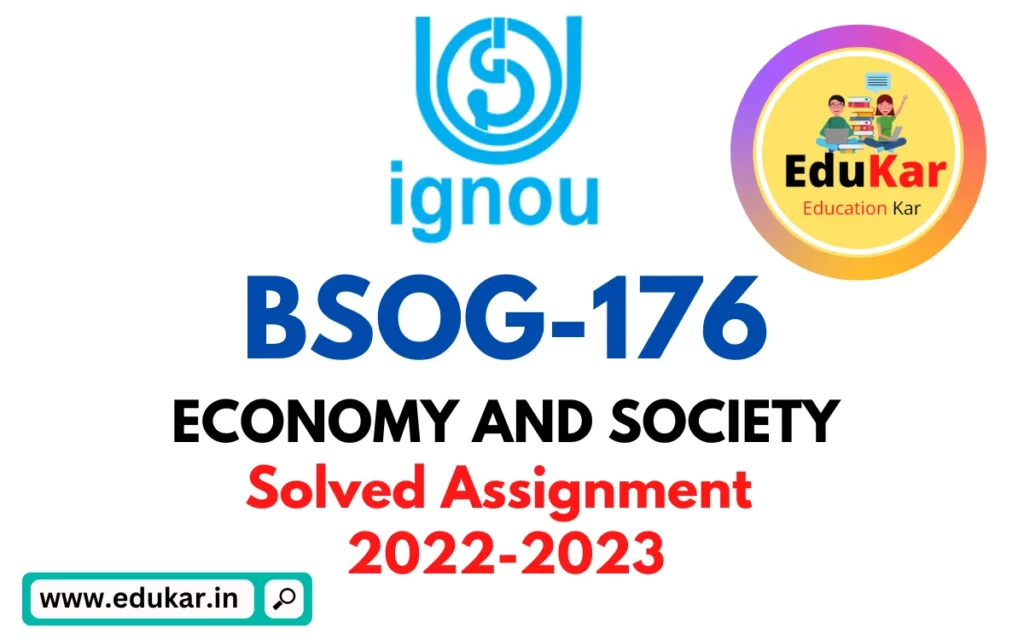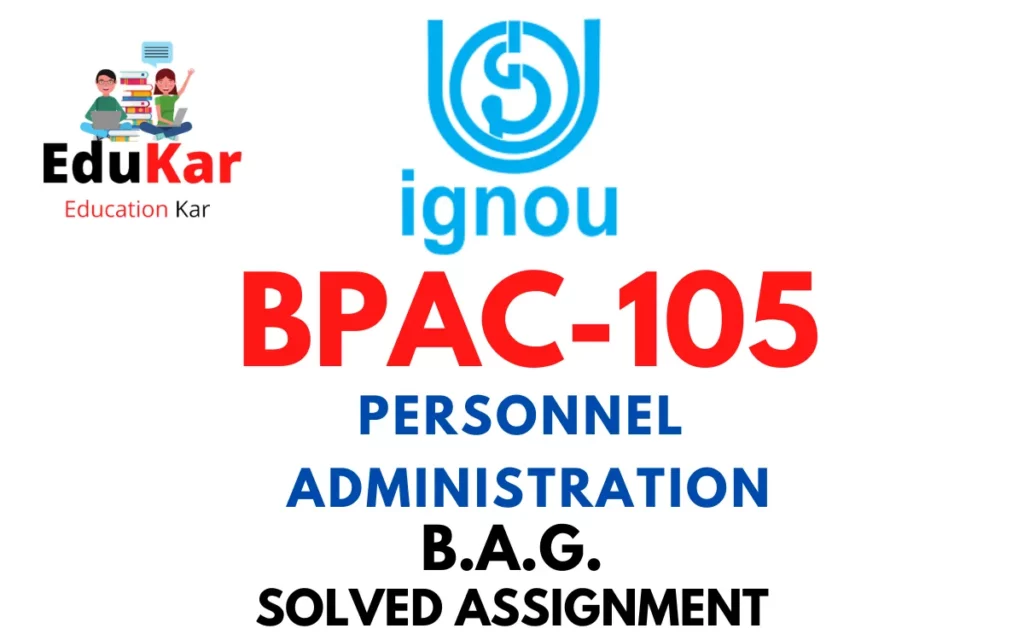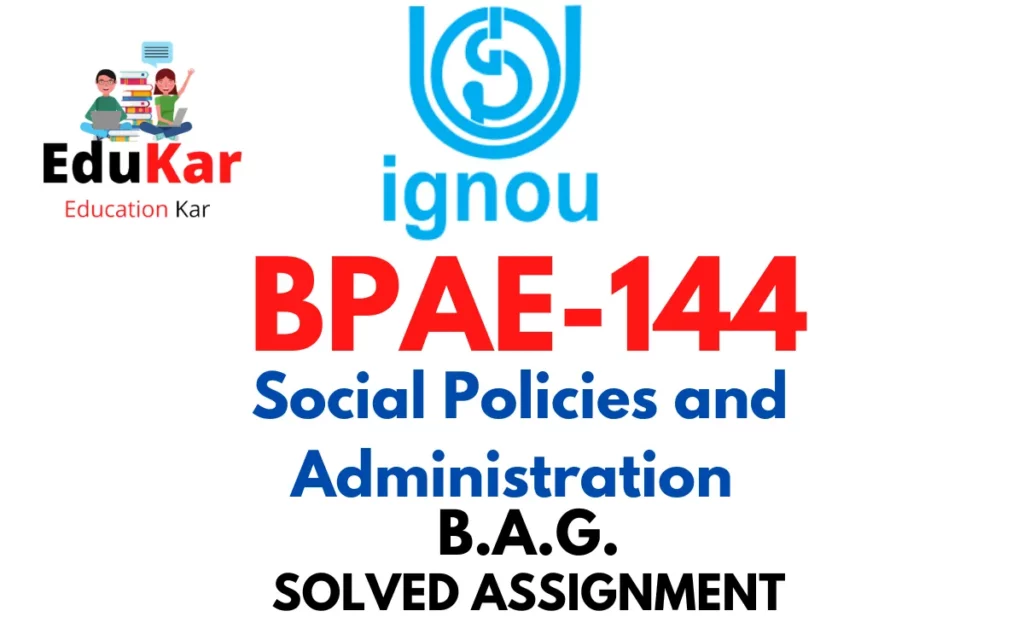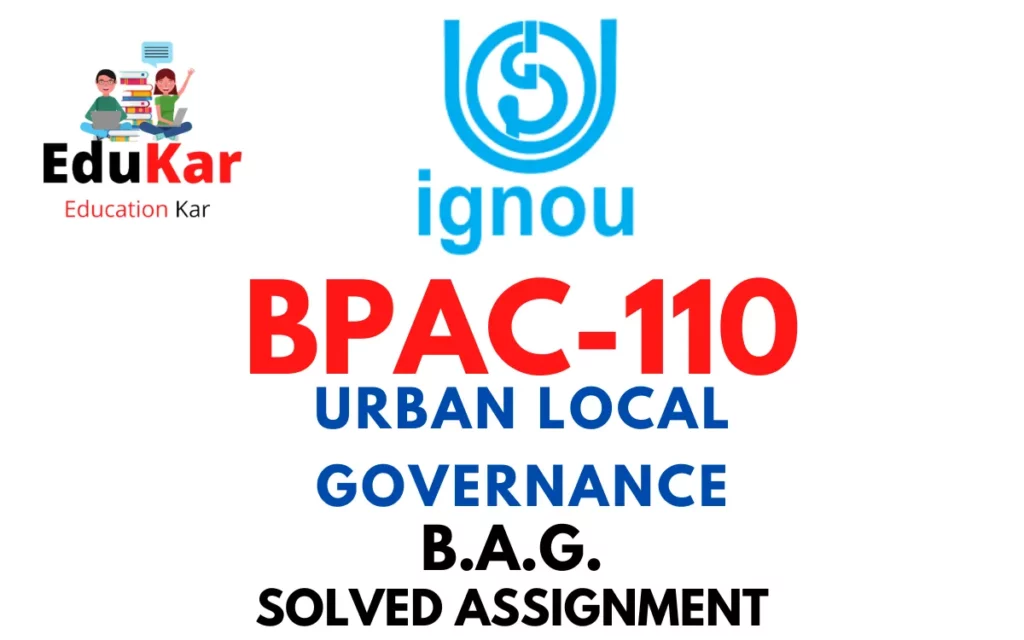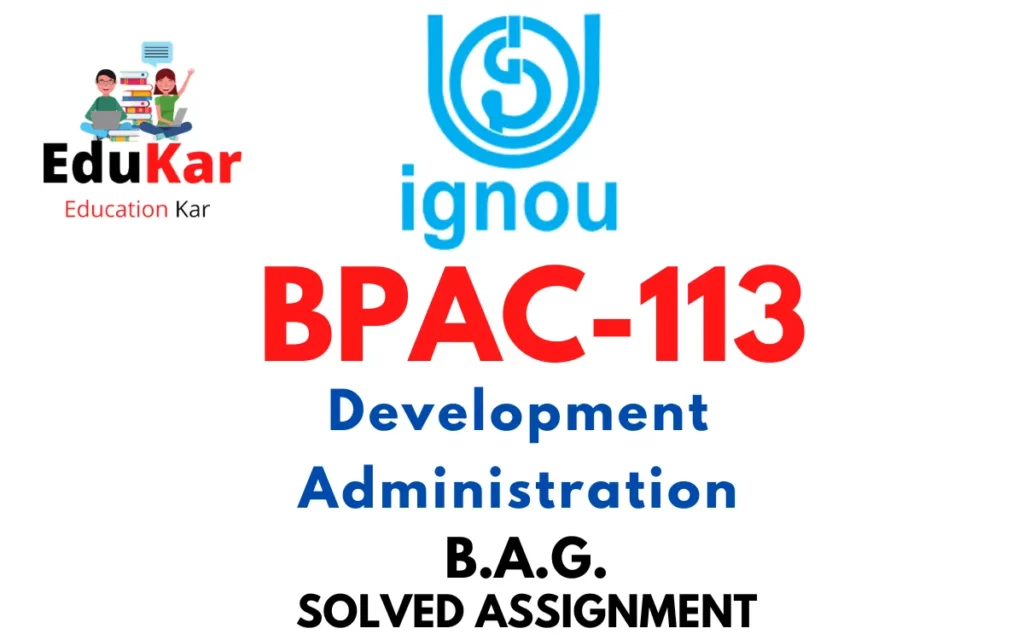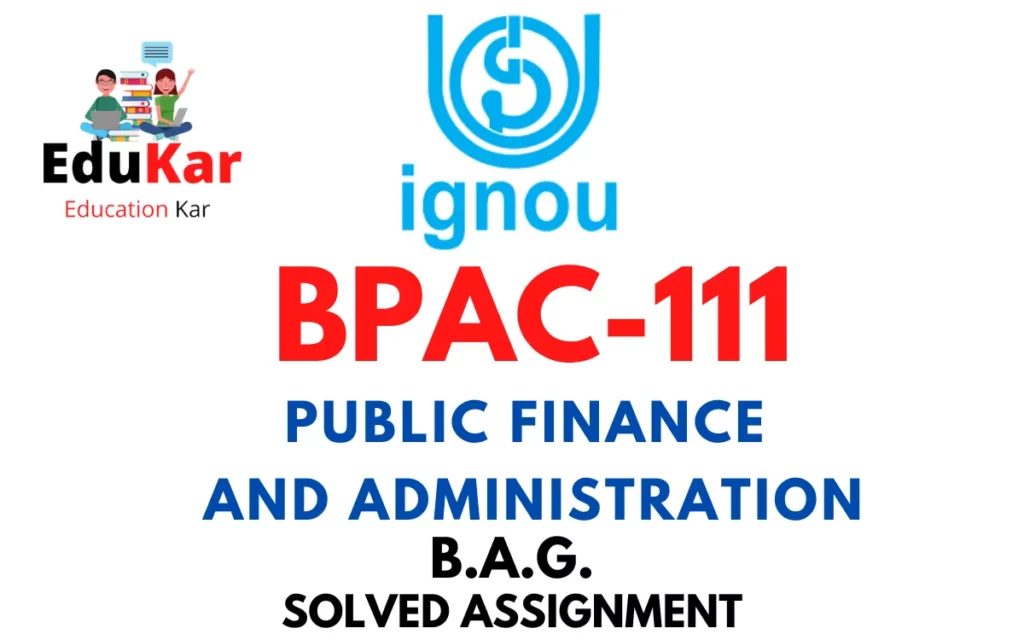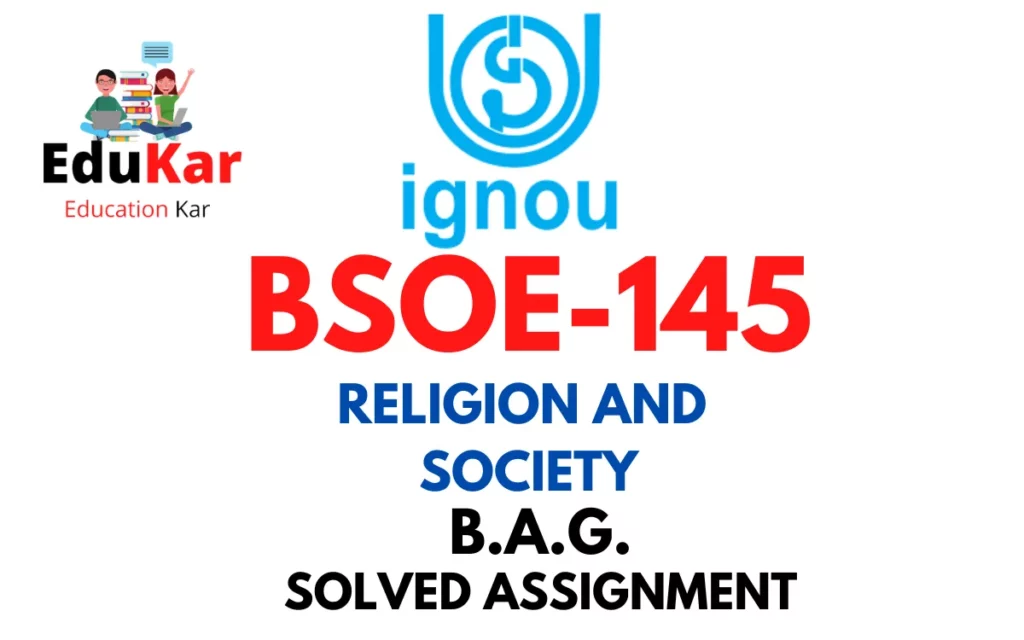Contents
- 1 Assignment A
- 2 Answer the following in about 500 words each.
- 3 1. Explain the concept of public systems management and also describe its characteristics.
- 4 2. Examine the role of legislature in governance.
- 5 Assignment B
- 6 Answer the following questions in about 250 words each.
- 7 3. Discuss the role of regulatory state.
- 8 4. Write a note on principles of total quality management.
- 9 5. Analyse the different forms of accountability.
- 10 Assignment C
- 11 Answer the following questions in about 100 words each.
- 12 6. Explain the concept and forms of network governance.
- 13 7. What is garbage can model of decision making?
- 14 8. State the advantages and disadvantages of enterprise resource planning.
- 15 9. Discuss the features of Right to Information.
- 16 10. Explain the concept of responsiveness.
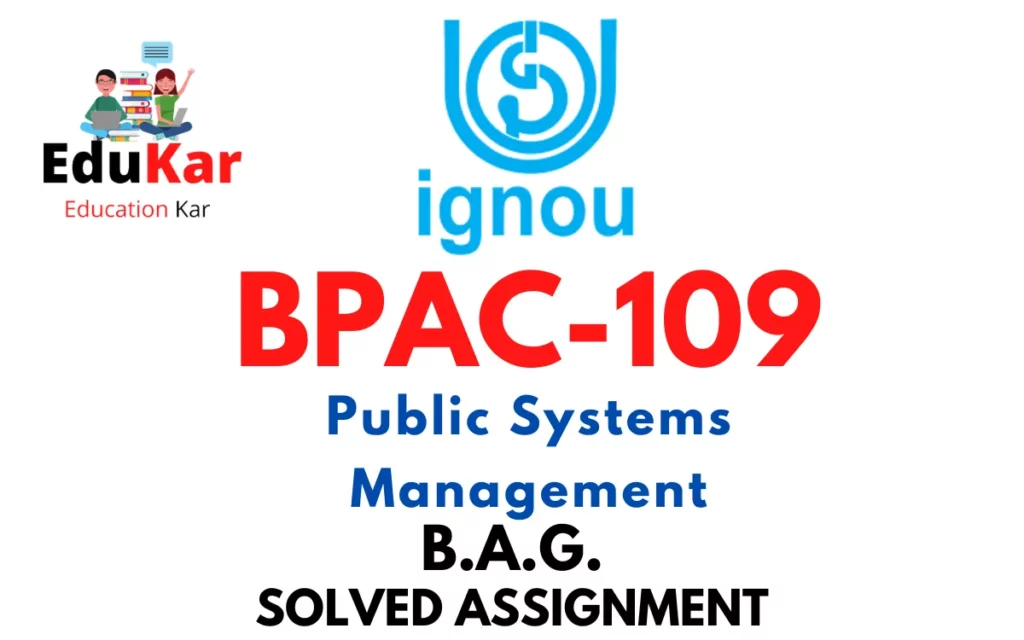
| Title | BPAC-109: IGNOU BAG Solved Assignment 2022-2023 |
| University | IGNOU |
| Degree | Bachelor Degree Programme |
| Course Code | BPAC-109 |
| Course Name | Public Systems Management |
| Programme Name | Bachelor of Arts (General) |
| Programme Code | BAG |
| Total Marks | 100 |
| Year | 2022-2023 |
| Language | English |
| Assignment Code | ASST /TMA / July 2022-January 2023 |
| Assignment PDF | Click Here |
| Last Date for Submission of Assignment: | For June Examination: 31st April For December Examination: 30th September |
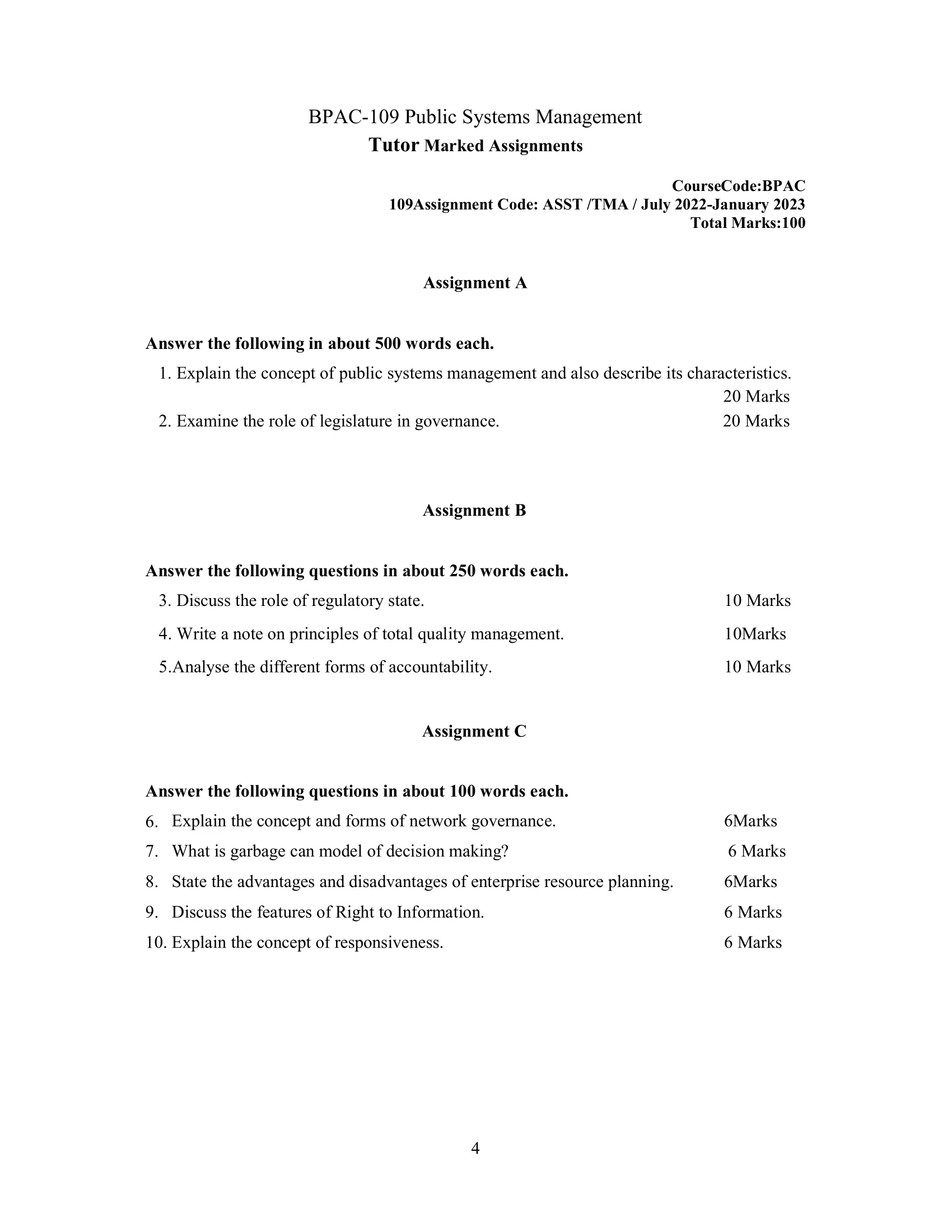
Assignment A
Answer the following in about 500 words each.
1. Explain the concept of public systems management and also describe its characteristics.
Ans: Public systems management refers to the process of designing, implementing, and evaluating public policies, programs, and services to meet the needs of the community. It is the process of managing public resources to ensure that they are utilized effectively and efficiently to meet the needs of the public. Public systems management involves the use of public resources such as human capital, financial capital, and physical capital to deliver public services and achieve the goals and objectives of the government.
One of the key characteristics of public systems management is that it is focused on the public good. Public systems management is concerned with meeting the needs of the community and ensuring that public resources are used to improve the quality of life of the citizens. The ultimate goal of public systems management is to improve the well-being of the public, which may include improving public health, education, and safety.
Another important characteristic of public systems management is that it is a collaborative process. Public systems management involves working with a variety of stakeholders, including government agencies, non-profit organizations, and private sector entities, to develop and implement policies and programs. Collaboration and partnership are essential in public systems management, as it involves addressing complex problems that require the expertise and resources of multiple organizations.
Public systems management also involves a high level of accountability and transparency. Public systems management requires government agencies to be accountable to the public for their actions and decisions. Public officials must be transparent in their decision-making processes and ensure that they are acting in the best interest of the public.
Finally, public systems management is a continuous process. Public systems management involves ongoing assessment and evaluation of policies and programs to ensure that they are meeting the needs of the community. Public systems management also involves making adjustments and improvements to policies and programs to ensure that they are effective and efficient.
2. Examine the role of legislature in governance.
Ans: The legislature plays a crucial role in governance by representing the people and making laws that govern society. Legislatures are typically made up of elected representatives who are responsible for creating, reviewing, and passing laws that impact the lives of their constituents.
Here are some of the ways in which legislatures contribute to governance:
- Lawmaking: Legislatures are responsible for creating laws that govern society. These laws can address a wide range of issues, including public safety, education, healthcare, and social welfare.
- Representation: Legislators are elected to represent their constituents and advocate for their interests. They provide a channel for citizens to participate in the political process and influence decision-making.
- Oversight: Legislatures provide oversight over the executive branch of government, ensuring that laws are being implemented as intended and that public resources are being used effectively.
- Budgeting: Legislatures are responsible for approving budgets and allocating public funds. They help ensure that public resources are being used to benefit society as a whole.
- Accountability: Legislatures provide a forum for holding government officials accountable for their actions. Through investigations, inquiries, and other oversight mechanisms, legislatures can expose corruption and other forms of misconduct.
Assignment B
Answer the following questions in about 250 words each.
3. Discuss the role of regulatory state.
Ans: The regulatory state refers to the government’s role in regulating and overseeing economic and social activity. The regulatory state is responsible for creating and enforcing rules and standards that protect public health, safety, and welfare. The role of the regulatory state is to ensure that businesses and individuals act in ways that are consistent with the public interest and that do not harm society as a whole.
One of the primary functions of the regulatory state is to establish and enforce regulations that promote competition and prevent monopolies. This is important because monopolies can harm consumers by charging high prices, limiting choice, and reducing innovation. The regulatory state can also intervene in cases where businesses engage in anticompetitive behavior, such as price-fixing, collusion, or other forms of market manipulation.
Another important role of the regulatory state is to protect public health and safety. This can include regulating food and drug safety, occupational safety and health, and environmental protection. The regulatory state can also play a role in consumer protection, ensuring that products are safe and that businesses are transparent and honest in their dealings with consumers.
The regulatory state can also help to promote social welfare by establishing and enforcing policies that promote equality, fairness, and social justice. This can include regulations related to employment, housing, and education, as well as policies aimed at reducing poverty and promoting economic opportunity.
4. Write a note on principles of total quality management.
Ans: Total Quality Management (TQM) is a management approach that focuses on continuous improvement in all aspects of an organization. The principles of TQM provide a framework for organizations to achieve high levels of quality, customer satisfaction, and efficiency.
Here are some of the key principles of Total Quality Management:
- Customer Focus: Meeting the needs and expectations of the customers is the central focus of TQM. By understanding the customer’s requirements, organizations can ensure that their products and services meet or exceed their expectations.
- Continuous Improvement: TQM emphasizes the continuous improvement of all processes within the organization. This involves constantly looking for ways to improve quality, reduce waste, and increase efficiency.
- Employee Involvement: The involvement of employees at all levels of the organization is essential for the successful implementation of TQM. Employees should be empowered to identify and solve problems, suggest improvements, and contribute to the overall success of the organization.
- Leadership: Leaders in the organization should provide clear direction, vision, and support for TQM. They should also be committed to continuous improvement and encourage the same from their employees.
- Process Approach: TQM takes a process approach, where all activities are viewed as interconnected processes. Each process should be monitored and optimized to ensure that it contributes to the overall success of the organization.
- Data-Driven Decision Making: TQM emphasizes the use of data and facts to make decisions. Data should be collected, analyzed, and used to make informed decisions that lead to improved quality and efficiency.
- Supplier Relationships: TQM recognizes the importance of building strong relationships with suppliers. By working closely with suppliers, organizations can ensure that the quality of the inputs they receive is high, leading to improved quality of the outputs.
5. Analyse the different forms of accountability.
Ans: Accountability is a concept that refers to the obligation to accept responsibility for actions, decisions, and their consequences. There are several different forms of accountability, including:
- Legal Accountability: Legal accountability refers to the obligation to comply with the law and to be held responsible for any violations. This type of accountability is enforced through the legal system, with penalties such as fines or imprisonment for non-compliance.
- Financial Accountability: Financial accountability refers to the obligation to manage financial resources effectively and to be held responsible for their use. This type of accountability is typically enforced through audits and financial reporting requirements.
- Social Accountability: Social accountability refers to the obligation to respond to the needs and interests of stakeholders and to be held responsible for social and environmental impacts. This type of accountability is often enforced through social pressure, media coverage, and public opinion.
- Professional Accountability: Professional accountability refers to the obligation to maintain professional standards and to be held responsible for the quality of work performed. This type of accountability is typically enforced through professional bodies and licensing requirements.
- Political Accountability: Political accountability refers to the obligation of elected officials to be responsive to the needs and interests of their constituents and to be held responsible for their actions and decisions. This type of accountability is enforced through the electoral process, with the possibility of being voted out of office.
- Performance Accountability: Performance accountability refers to the obligation to achieve desired results and to be held responsible for the outcomes of one’s actions. This type of accountability is typically enforced through performance management systems and performance metrics.
Assignment C
Answer the following questions in about 100 words each.
6. Explain the concept and forms of network governance.
Ans: Network governance is a model of governance that emphasizes collaboration, cooperation, and partnerships among different actors, such as government agencies, non-governmental organizations, businesses, and community groups, to address complex societal problems. It is a decentralized approach that recognizes that no single actor or organization can solve problems on its own. Instead, it seeks to create a network of actors with diverse perspectives and resources who can work together to achieve common goals. There are different forms of network governance, such as policy networks, inter-organizational networks, and community networks, which vary in their structure, goals, and level of formality.
Policy networks are formed around a specific policy issue, and their members include government agencies, interest groups, and academic experts. Inter-organizational networks are formed among different organizations, such as public-private partnerships, to achieve specific goals. Community networks are formed among residents and community-based organizations to address local issues. In all cases, network governance is based on shared values, trust, and mutual respect, and its success depends on the willingness of actors to collaborate and share information and resources.
7. What is garbage can model of decision making?
Ans: The garbage can model of decision making is a model developed by Michael D. Cohen, James G. March, and Johan P. Olsen in 1972. It is a model that describes how decisions are made in organizations with multiple actors, problems, and solutions, which are not necessarily well-defined.
According to this model, decisions are not made in a linear, rational process but are rather a result of a mixture of problems, solutions, participants, and opportunities, which are often disjointed and unstructured. These elements are compared to a garbage can, and the model suggests that when they are mixed together, a decision is reached.
The model assumes that there are four main components that influence decision making, which are: problems, solutions, participants, and choice opportunities. Each of these components is described as a separate “garbage can,” and when they interact, a decision emerges.
The model suggests that decision-making in organizations is often chaotic, with various problems and solutions being randomly thrown into the “garbage cans,” and decision-makers are constantly scanning these “cans” to find possible matches. The outcome of the decision-making process is therefore unpredictable, as it depends on the problems, solutions, participants, and choice opportunities that are present at any given time.
8. State the advantages and disadvantages of enterprise resource planning.
Ans: Enterprise Resource Planning (ERP) is a software system that helps businesses manage and integrate their core business processes, such as accounting, inventory, manufacturing, and customer relationship management. ERP systems offer several advantages and disadvantages that organizations should consider before implementing them.
Advantages of ERP:
- Improved Efficiency and Productivity: An ERP system streamlines business processes, eliminates duplication, reduces manual efforts, and automates workflows, resulting in increased productivity and efficiency.
- Data Integrity and Accuracy: An ERP system provides a single source of truth for all business data, reducing the risk of errors and inconsistencies across different departments.
- Better Collaboration: ERP systems encourage collaboration between different departments and teams by providing access to real-time data, fostering communication, and improving decision-making.
- Improved Customer Service: An ERP system allows businesses to access customer data, purchase history, and communication history, enabling them to provide better and more personalized customer service.
- Cost Savings: ERP systems can help businesses reduce costs by improving efficiency, reducing inventory, and optimizing supply chain management.
Disadvantages of ERP:
- High Implementation Costs: ERP systems can be expensive to implement, requiring significant investment in hardware, software, and personnel.
- Complex Implementation: Implementing an ERP system can be complex, requiring significant changes to business processes, employee training, and change management.
- Customization Challenges: ERP systems are designed to be generic and may not meet specific business requirements without customization, which can be costly and time-consuming.
- Dependence on the Vendor: Organizations that implement an ERP system become dependent on the vendor for ongoing support and maintenance, which can lead to long-term costs and vendor lock-in.
- Security Risks: ERP systems store large amounts of critical business data, making them attractive targets for cyberattacks and data breaches. Organizations must implement robust security measures to mitigate these risks.
9. Discuss the features of Right to Information.
Ans: The Right to Information (RTI) is a fundamental right that enables citizens to access information held by public authorities. It is a tool for promoting transparency and accountability in governance. The following are some of the key features of the Right to Information:
- Access to Information: The right to information guarantees citizens the right to access information held by public authorities. This includes information on policies, decisions, budgets, contracts, and other public records.
- Governmental Transparency: The right to information promotes transparency in government by making information available to citizens. This helps to hold government officials accountable for their actions and decisions.
- Timely Response: Public authorities are required to respond to RTI requests in a timely manner. The time limit for responding to a request varies depending on the nature of the information requested and the complexity of the request.
- Low Cost: The right to information is often available at a low cost or for free. This helps to ensure that citizens can access information without facing financial barriers.
- Non-Discrimination: The right to information is available to all citizens, regardless of their gender, race, religion, or social status. Public authorities are not allowed to discriminate against anyone who requests information.
- Protection of Whistleblowers: Whistleblowers who disclose information in the public interest are protected by law. This helps to ensure that individuals who expose corruption or other wrongdoing are not victimized or retaliated against.
- Independent Oversight: The right to information is often overseen by independent bodies, such as Information Commissions or Ombudsman Offices. These bodies ensure that public authorities comply with the law and respond to RTI requests in a timely and efficient manner.
10. Explain the concept of responsiveness.
Ans: Responsiveness is a concept that describes an organization’s ability to quickly and effectively respond to changes in the market, customer needs, or other external or internal factors that affect its operations. It is a critical aspect of a company’s success, as it enables the organization to adapt to changing circumstances, remain competitive, and continue to meet the needs of its stakeholders.
Responsiveness can manifest in several ways, including:
- Customer Service: A responsive organization is one that is proactive in meeting the needs and expectations of its customers. This includes prompt response to inquiries, quick resolution of complaints, and regular communication to ensure customers feel valued and heard.
- Agility: A responsive organization is one that can quickly adapt to changes in the market, such as changes in customer demand or shifts in industry trends. This requires a flexible and adaptive approach to operations, as well as the ability to quickly implement new ideas or products.
- Communication: A responsive organization is one that fosters open and transparent communication both within the organization and with external stakeholders. This allows for quick sharing of information, effective collaboration, and an ability to respond quickly to emerging challenges or opportunities.
- Innovation: A responsive organization is one that encourages innovation and creativity in its operations. This includes a willingness to take risks, test new ideas, and experiment with new products or services to meet changing needs.
How to Download BPAC-109 Solved Assignment?
You can download it from the www.edukar.in, they have a big database for all the IGNOU solved assignments.
Is the BPAC-109 Solved Assignment Free?
Yes this is absolutely free to download the solved assignment from www.edukar.in
What is the last submission date for BPAC-109 Solved Assignment?
For June Examination: 31st April, For December Examination: 30th October


